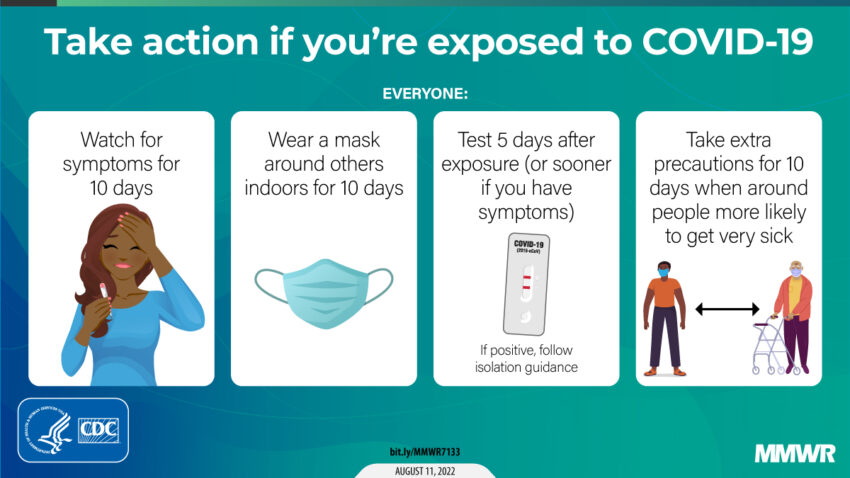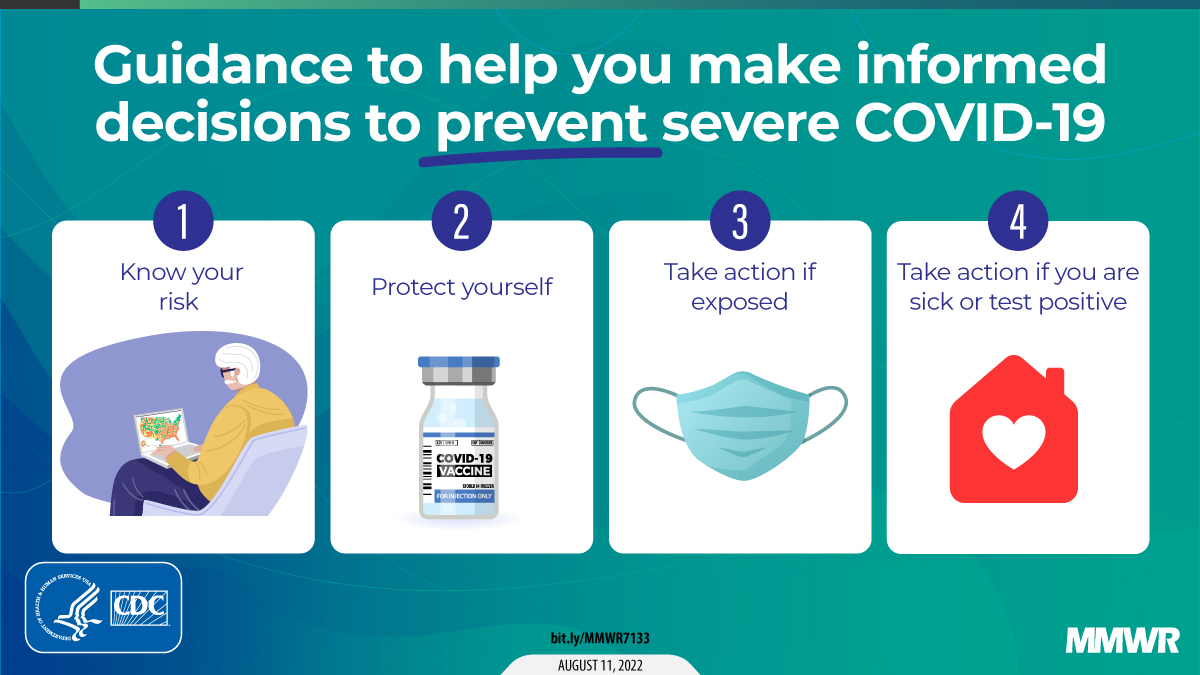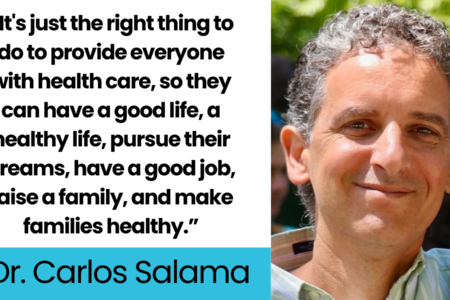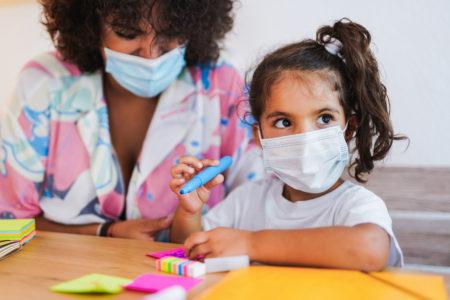
Share On Social!
COVID-19 is not over, especially for Latinos.
To help people stay vigilant in stopping the spread, the CDC recently published an updated Summary of Guidance for Minimizing the Impact of COVID-19 on Individual Persons, Communities, and Health Care Systems.
“To prevent medically significant COVID-19 illness and death, persons must understand their risk, take steps to protect themselves and others with vaccines, therapeutics, and nonpharmaceutical interventions when needed, receive testing and wear masks when exposed, receive testing if symptomatic, and isolate for [greater than or equal to] 5 days if infected,” the CDC reported on Aug. 11, 2022.
Vaccines and Therapeutics to Reduce Medically Significant Illness
The CDC recommends a strategic approach to minimize the impact of COVID-19 on health and society that relies on:
- Vaccination and therapeutics to prevent severe illness.
- The use of multicomponent prevention measures where feasible.
- A particular emphasis on protecting persons at high risk for severe illness.
The CDC expressed that COVID-19 vaccines are highly protective against severe illness and death and provide less protection against asymptomatic and mild infection.
“The rates of COVID-19–associated hospitalization and death are substantially higher among unvaccinated adults than among those who are up to date with recommended COVID-19 vaccination, particularly adults aged [older than or equal to] 65 years,” according to the CDC.
The CDC also highlights how booster coverage in the U.S. remains low, causing racial and ethnic disparities in booster coverage.
Therefore, it is important to supporting community partnerships and leverage trusted sources of information.
“Public health efforts need to continue to promote up-to-date vaccination for everyone, especially with vaccines targeting emerging novel variants that might be more transmissible or immune-evasive,” the CDC reported.
For those who are moderately or severely immunocompromised, preexposure prophylactic medication can benefit from COVID-19 and help prevent severe COVID-19 illness.
“Preexposure prophylaxis with Evusheld can help protect persons with moderate to severe immunocompromise who might not mount an adequate immune response after COVID-19 vaccination, as well as persons for whom COVID-19 vaccination is not recommended because of their personal risk for severe adverse reactions,” according to the CDC.
Regarding COVID-19 medications, the CDC mentions that antiviral medications and monoclonal antibodies are available to treat COVID-19 for those who are at increased risk for severe illness including older adults, unvaccinated persons, and those with certain medical conditions.
COVID-19 Prevention Strategies
Several prevention strategies can protect individuals and communities from SARS-CoV-2, the virus behind COVID-19.
For example, diagnostic testing for current infection can help detect infection early, reduce the risk of spreading the virus, and allow the patient to receive treatment, according to the CDC.
Isolation also serves as a prevention strategy for those that are symptomatic or infected.
“Infected persons should remain in isolation for [greater than or equal to] 5 days and wear a well-fitting and high-quality mask or respirator if they must be around others,” the CDC states. “Infected persons may end isolation after 5 days, only when they are without a fever for [greater than or equal to] 24 hours without the use of medication and all other symptoms have improved, and they should continue to wear a mask or respirator around others at home and in public through day 10.”
COVID-19 outbreaks “help signal when use of some prevention strategies should be discontinued or increased, based on an individual person’s level of risk for severe illness or that of their household or social contacts,” according to the CDC.
For managing SARS-CoV-2 exposures, the CDC now recommends case investigation and contact tracing only in health care settings and certain high-risk congregate settings.
“Persons who have had recent confirmed or suspected exposure to an infected person should wear a mask for 10 days around others when indoors in public and should receive testing [greater than or equal to] 5 days after exposure (or sooner, if they are symptomatic), irrespective of their vaccination status,” the CDC states.
Protecting Persons Most at Risk for Severe Illness
COVID-19 prevention strategies aim to help reduce the risk of infection for those with a higher risk of severe illness, including those older in age, disability, moderate or severe immunocompromise, or other underlying medical conditions (including pregnancy).
Individuals at high risk for severe illness and their contacts should consider wearing “well-fitting masks or respirators that provide more protection to the wearer because of better filtration and fit to reduce exposure and infection risk” in communities with medium or high levels of COVID-19 exposure, according to the CDC.
The CDC also encourages health equity by recommending public health practitioners and organization to communicate and reach all populations at high risk for severe illness to increase access to preexposure prophylaxis, testing, and oral antivirals.
“Public health practitioners and organizations should consider the characteristics of their local or setting-specific populations when determining whether to strengthen or add prevention strategies that supplement disease control efforts and protect those persons at highest risk for severe illness or death,” The CDC says.
How Can I Minimize the Impact of COVID-19?
You can help by promoting vaccines and prevention strategies in the wake of the misinformation that challenges many Latino adults and younger Latinos.
To encourage Latinos to get vaccinated, Salud America! is sharing stories of real Latinos who are squashing misinformation and getting vaccinated.
For example, Rosa Herrera!
Rosa found herself hesitant to get the COVD-19 vaccine after reading misinformation on Facebook.
However, after COVID-19 hit close to home, causing her children to become hospitalized, and several of her other family members getting vaccinated, Herrera began to reconsider.
After more research and consideration, Herrera decided to get vaccinated. Now, Herrera helps others schedule vaccination appointments!
“I tell them, ‘I already did it, you can do it! Nothing is going to happen to you. Nothing happened to me,” Herrera said. “But then at the same time, I let them know that everybody reacts differently because, we’re not all the same. But I think it’ll be better for them to get the vaccine to protect themselves, but mainly for their family members.”
Find COVID-19 vaccination locations near you in English and Spanish.
By The Numbers
142
Percent
Expected rise in Latino cancer cases in coming years




[…] The pandemic is another chapter in the bitter story of American racism and inequality. Black and Latinx people are being infected and are dying at much higher rates than white Americans. Many people of […]
[…] coronavirus has killed over 61,000 Latinos in America according to the CDC, accounting for over 18.2% of the total COVID deaths in the […]
[…] Whereas Hispanics make up 11% of D.C.’s inhabitants, they signify 19% of the COVID cases, and 14% of the deaths. Equally, 46% of D.C.’s residents are Black, they usually make up an alarming 75% […]
[…] and historical mistreatment. According to the U.S. Centers for Disease Control and Prevention, Latino and Black American communities are three times more likely to become infected with […]
[…] Covid pandemic has hit the Latino community particularly hard, and data from the nonprofit health equity advocacy group Salud America! shows Latinos lead in the 0-24 age […]
[…] the pandemic, Latinos took major blows, both in terms of COVID-19 cases and also from the economic recession under former President Donald Trump. Nearly half (49%) of […]
[…] the positive trend, the harm may have already been done. The pandemic has disproportionately impacted Latino communities. Reuters reported that election-related or political disinformation that […]
[…] pesar de la tendencia positiva, es posible que el daño ya esté hecho. La pandemia ha impactado desproporcionadamente Comunidades latinas. Reuters informó que la desinformación política o relacionada con las […]
[…] residentes blancos muestran una tasa mucho más baja con 10 muertes por cada 100,000 habitantes(8 9) . Los afroestadounidenses por su parte, denuncian subsistemas de salud que les segregan […]
[…] https://salud-america.org/coronavirus-case-rates-and-death-rates-for-latinos-in-the-united-states/ […]
[…] https://salud-america.org/coronavirus-case-rates-and-death-rates-for-latinos-in-the-united-states/ […]
[…] communities have the second-highest number of COVID-19 cases in the U.S. They’re also more likely to become hospitalized and die from the disease than other […]
[…] total, around 160,000 Latinos were killed by COVID-19. This accounts for 16% of the 1 million deaths in the country. The […]